How to freeze tomatoes for the winter and how they can be used in the future
For many housewives, the very idea of freezing tomatoes for the winter may seem unusual. However, in reality, these vegetables can be harvested in this way no worse than any other. True, it’s not always possible to make a salad of such tomatoes in winter, but there are many other ways to use them, in which the frozen product will not be inferior to fresh in anything. We will tell you about all the secrets of tomato freezing in this review.
Is it possible to freeze tomatoes
Still few people freeze tomatoes, and in vain. This method of harvesting has several disadvantages, but it still has many more advantages. When deciding whether to stock up on tomatoes for the winter, storing them in the freezer, and how best to do this, it is important to understand well what qualities of the product will remain after thawing and which will be lost. This is where we start.

The benefits of freezing
- The advantages of tomato freezing include the following qualities:
- Speed and ease of execution: freezing does not require much effort and time, is not associated with the need to stand at the hot plate, which is especially unpleasant in the summer heat.
- Preservation of the beneficial properties of vegetables: during conservation, the bulk of vitamins and other valuable substances contained in vegetables are irretrievably lost, while low temperatures do not lead to this effect.
- Profitability: harvesting is carried out at a time when seasonal vegetables are very cheap, while the price of fresh tomatoes is prohibitive in winter.
- Safety: seasonal products grown without growth stimulants and other chemical additives are frozen, which cannot be said about vegetables delivered to store shelves in winter. In addition, no preservatives are used in the preparation - salt, vinegar, sugar, etc., thus, the product remains completely natural.
- Preservation of taste and smell: with proper use of tomatoes after defrosting, dishes with them will be just as tasty and aromatic as if fresh vegetables were added to them. Winter tomatoes are practically odorless and tasteless and only in appearance look like a favorite vegetable.
- Simplicity in future use: for the preparation of many dishes, tomatoes need to be freed from the skins, and fresh vegetables for this purpose need to be blanched (lowered in boiling water for a short time). After defrosting, the skin is removed from the tomato very easily, without additional procedures.
Did you know? The author of the technology of shock freezing products is an American named Clarence Beardsay, formerly a taxidermist. The Eskimos from the Labrador Peninsula, which Berdsay visited as part of a scientific expedition, prompted the young adventurer with a good idea. Northern residents immediately laid out the caught fish on the ice, where, under the influence of the Arctic wind, it froze in a matter of minutes. Such a product could subsequently be stored for months, and, unlike ordinary freezing, after thawing, its taste qualities did not change at all.
Minuses
- If we talk about the downsides of freezing, then they are as follows:
- After defrosting, the tomato completely loses its structure, so you can only use it for making mashed potatoes, pasta or subsequent heat treatment.
- You can only store the workpiece in a freezer, the volume of which is limited.
- The thawed product must not be frozen repeatedly. This means that if during the winter, for example, due to power outages, the vegetables begin to thaw, all the stockpiles will be damaged or their quality will be severely affected.
How to freeze tomatoes for the winter in the freezer
Freezing foods is much easier than canning or even drying. All that is needed for harvesting is high-quality raw materials, the right utensils, a modern freezer and a clear idea of what frozen vegetables will be used for (the technology of freezing depends on the latter).

Selection of tomatoes and preparation for freezing
In principle, you can freeze any tomatoes.
But it is better to be guided by the following rules when choosing raw materials:
- Early tomatoes are not suitable for any harvesting. They contain the minimum amount of nutrients, they are designed to quickly meet the need for vitamins after winter, and for other purposes it makes no sense to use them.
- Ideal raw materials for harvesting are products grown in their own summer cottage or purchased from a trusted seller who uses his vegetables not only for sale, but also for eating in his family. Modern technologies use various methods to improve the yield and external characteristics of the fruit, but, unfortunately, most of these methods adversely affect the quality and environmental safety of the goods.
- The best tomato crop can be obtained in the greenhouse, but vegetables grown in the garden are more suitable for harvesting: much less nitrate accumulates in them.
- For freezing, it is preferable to select tomatoes of the same size, better than average. Fruits should not have stains, damage, signs of disease or decay. Their integrity should not be violated.
- It is advisable to freeze meaty varieties of tomatoes, in which there is more pulp than juice.
- For harvesting, only fully ripe, but not overripe fruits should be used.
Before processing, the tomatoes need to be washed (especially carefully this should be done with the goods purchased on the side) and let the water drain completely. The skin of the fruit must be completely dry.
Important! The less time elapses between the removal of the vegetable from the garden and its freezing, the more nutrients will be stored in the product.
What kind of kitchen equipment do you need
Depending on which method of freezing will be chosen, for work you may need:
- sharp knife;
- a blender or meat grinder;
- cutting board;
- cling film, parchment paper or foil;
- containers for freezing and storage: plastic containers with a tight-fitting lid, molds for ice, plastic bags for freezing with a special lock-slider, etc.

Freezing methods
It is best to freeze foods in No Frost refrigerators. The super-freezing mode, if any, must be turned on at least 2 hours before placing tomatoes in the chamber. It is advisable that the temperature in the freezer by this moment be no lower than –24 ° C. There are several ways to freeze tomatoes. Each of them has a right to exist, but when choosing between them, you should first focus on a specific dish for which the vegetable will be used (for example, whole tomatoes are needed for some recipes, chopped ones for others, tomato puree for others, etc. P.).
Did you know? Classic shock freezing is only possible in an industrial environment. Modern household refrigerators have a super-freeze mode, which is the closest analogue to the “right” technology. The essence of the function is the forced shutdown of the thermostat, after which the compressor starts to work continuously, respectively, the temperature in the chamber decreases so much that the product placed in it does not freeze gradually, from the peel to the middle, but immediately and completely. Only in this case, its useful properties are preserved as much as possible.
Whole
The easiest and most sophisticated way.
Here is all you need to do:
- Put the washed, washed and dried tomatoes in a plastic bag (you can use a regular bag without a lock, just tie it up so that the tomatoes do not accidentally spill out during the process of extracting food from the freezer).
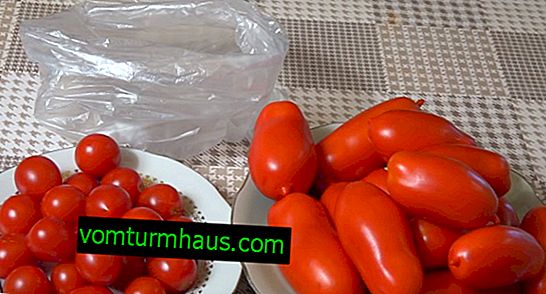
- Put the bag of tomatoes in the freezer, pre-cooled to the lowest possible temperature.
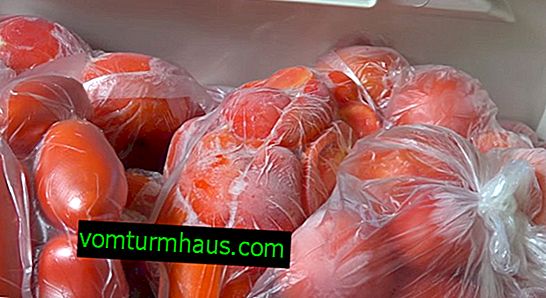
- After a few hours, making sure that the tomatoes have turned into absolutely solid balls, you can turn off the super freeze mode.
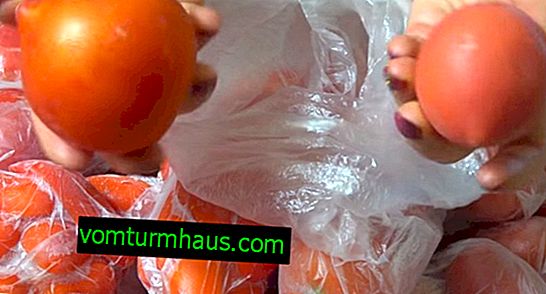
Video: whole tomato freezing
With the obvious simplicity of execution, this method has other advantages. Whole frozen tomatoes are stored longer than chopped ones; in addition, they do not need to be laid out in portioned containers, since the fruits are perfectly separated from each other and can be removed in such quantities as are necessary. You can cut a tomato into the required number of parts after thawing, while the peel from the vegetable will be removed by itself.
Did you know? It is estimated that with an increase in the storage temperature of frozen tomato from –18 ° C to –12 ° C, the amount of ascorbic acid contained in the fruit decreases by 20%.
Slices without peel
This method is suitable if you need to prepare a semi-finished product for dishes that use blanched (peeled) tomatoes.
In this embodiment, the technology is somewhat more complicated:
- On each tomato (it is better to use large-fruited), use a sharp knife to make 2 cross-shaped shallow cuts from the side opposite to the peduncle. It is advisable only to violate the integrity of the peel.

- Put the tomatoes in a deep bowl and pour boiling water.
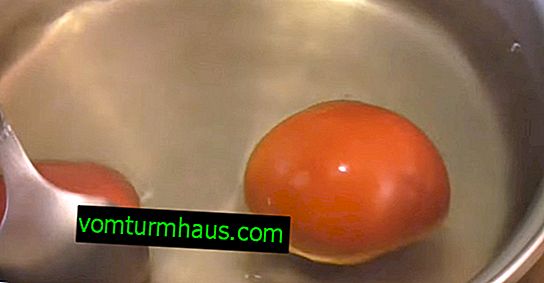
- After 1-2 minutes, use the slotted spoon to remove the fruits and remove the skin from them (it will easily separate from the pulp).

- Cut the peeled fruits into several slices.

- Put slices in 1 layer on a horizontal plane (cutting board, tray, large flat plate, etc.) pre-coated with cling film. If all the tomatoes did not fit, cover the slices with a new layer of film and lay out the second tier of fruits, if necessary, make a few more "floors". Cover the top layer with a film.
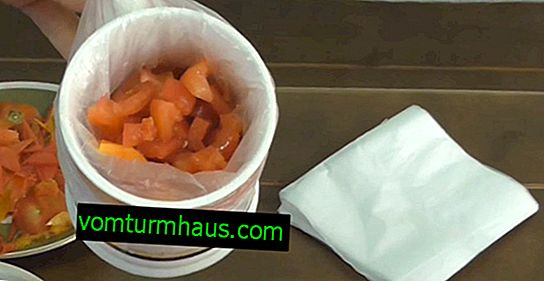
- Put the structure in the freezer, previously cooled as much as possible.
- After 10-12 hours, making sure that the vegetable is well frozen and completely solid, quickly put the slices into portion packets or other containers and send them back to the freezer, already in normal mode.
Video: peeling tomatoes without slices
Salad Pieces
If you really want to enjoy a salad of fresh tomatoes in the winter, you can try to do the following:
- Choose the most dense fruits of medium size, wash and dry them.
- With a sharp knife, cut each vegetable into 4-6 slices.
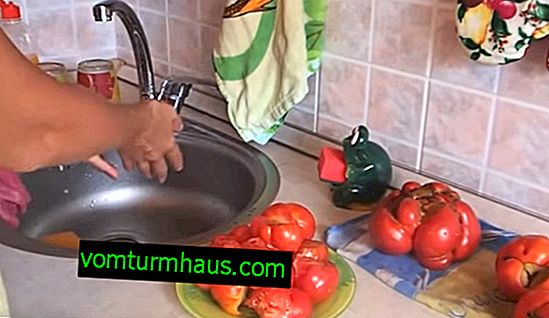
- Spread the slices on a tightened film plane in one layer so that the parts do not touch each other. Cover the tomatoes with another layer of film, so that during the freezing process they do not lose moisture and do not pull off odors.

- Put the plane with chopped tomatoes in the freezer for deep freezing for at least 12 hours.
- Take out the tomatoes very quickly, pack them in a more convenient container and put them back in the freezer.
Video: freezing tomatoes with slices for salad
Pizza mugs
Beautiful slices of tomatoes on pizza can be frozen in advance for the whole winter. To do this, you need:
- Select tomatoes of suitable sizes, wash and dry them.

- Carefully cut off the “hat” from each tomato along with the stem.

- Cut the rest of the fruit into circles of the same thickness.

- Put circles on a flat surface covered with a film according to the technology described above.
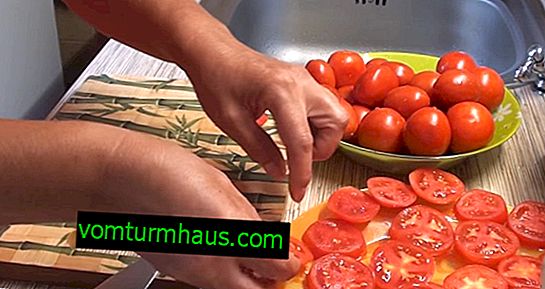
- Put a bowl of tomatoes in the freezer for quick freezing.
- After the set time (at least 12 hours) quickly, but carefully so as not to damage the correct shape of the tomatoes, put them in bags with a slide-lock or other suitable container for long-term storage and return them to the freezer.

Video: pizza freezing tomatoes
Stuffed
If the options listed above concerned the preparation of ingredients for cooking, then stuffed tomatoes are a full-fledged semi-finished product, from which you can cook an original and nutritious dish in just a few minutes.
Learn how to properly store tomatoes at home.
As a filler, you can use different fillings, for example:
- mushroom: finely chop the mushrooms, fry in a mixture of vegetable and butter with onions and garlic, salt, pepper to taste;
- pumpkin: peel the pumpkin, grate it with a coarse grater, add a little grated carrots, diced onions and chopped garlic, fry until tender, salt and pepper;
- vegetable: fry favorite vegetables or their mixtures in vegetable oil; for example, eggplant, bell peppers, onions, carrots and even cucumbers work well with tomatoes.

Technology for further action:
- Choose medium-sized round tomatoes, wash and dry them.
- With a sharp knife, cut off the “hat” from each tomato along with the stem.
- With a knife or spoon, remove part of the pulp so that a small “pot” is obtained (it is important not to damage the bottom and leave a sufficient layer of plant tissue below and on the sides, otherwise the filling will leak and burn during baking). Extracted pulp and juice can be used to freeze mashed potatoes.
- Stuff the tomatoes with minced meat.
- Put stuffed tomatoes on a plane lined with film or parchment, cover with a film from above and send to deep freeze.
- Not earlier than after 1 day, stuffed tomatoes can be transferred to a plastic container (bags are not suitable for this purpose).
Mashed Tomato
Tomato puree is often prepared by spinning, but in this case, you must add salt, sugar, vinegar and other preservatives to the dish, otherwise the contents of the jar will ferment. Freezing allows you to save puree from tomatoes in their natural form. To make mashed potatoes, absolutely any tomato will do. Fruits with minor damage can also be used, but the dubious part should be cut first.
Did you know? Tomato puree can be made from juice and pulp, which remain in the process of preparing sun-dried tomatoes (only the petals with a thin layer of pulp on the skin are used for drying). In this case, in addition to receiving two separate dishes, the hostess gets rid of the need to blanch and peel the tomatoes.
The procurement technology is as follows:
- Peel the tomatoes from the skins, pre-fill them with boiling water.
- Cut the pulp into arbitrary parts and beat with a blender or mince.

- Fill with the obtained puree portioned containers of such a volume that allows you to use its contents at a time. You can use ordinary plastic cups for these purposes, covering them with cling film and tightening with rubber, containers for making ice, etc.
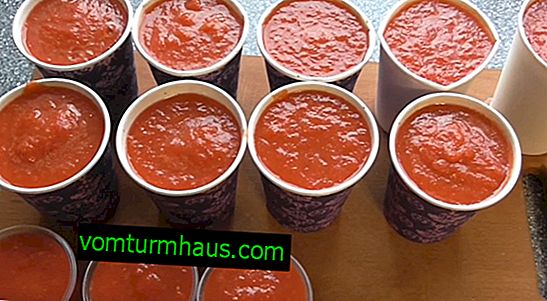
- Send containers with mashed potatoes for quick freezing.
- Glasses with frozen mashed potatoes can be left for storage in their original form. It is enough to extract tomato cubes from ice-making containers and pour them into bags with fasteners, plastic containers or another suitable container.
Video: freezing tomato puree
Tomato juice
Tomato juice is frozen using the same technology as mashed potatoes. All tomatoes without exception are also suitable for this, even slightly overripe (but only, of course, not green). If there is a juicer on the farm, then making juice will not be a problem. But you can do it with improvised means.
Important! You never need to defrost foods by putting them in water, much less hot.
In this case, the step-by-step instruction looks like this:
- Remove peel from tomatoes by blanching.
- Cut the pulp into small pieces and, if desired, beat in a blender or pass through a meat grinder (this will speed up the further process).

- Put slices of tomatoes or mashed potatoes in a sieve with a grid and carefully rub its contents over a saucepan or plate. The seeds and dense fragments remaining in the sieve can be used, for example, in the preparation of borsch.
- Arrange the finished juice in portioned containers and quickly freeze.

- If small molds were used for freezing, then pieces of “tomato ice” can be removed and transferred into bags or plastic containers. Larger containers are best left for permanent storage in the freezer.
Video: how to make tomato juice for the winter
Basic storage rules
Properly frozen tomatoes are stored from 10 months to 1 year, and before the ripening of a new crop they can and should be used.
Однако для того чтобы продукт не потерял своих качеств, как питательных, так и вкусовых, необходимо соблюдать такие рекомендации:
- Хранить продукты в морозильной камере следует только в закрытой таре. Если помидоры были разрезаны на части, такая тара, по возможности, должна быть герметичной.
- После того как продукт начал оттаивать, замораживать его повторно нельзя.
- В момент помещения помидора в морозилку он должен быть сухим, но предварительно вымытым (после разморозки овощи не моются).
- Низкие температуры не сделают из испорченного продукта свежий. Нельзя отправлять в морозилку некачественное сырьё.
- После шоковой заморозки овощи всегда нужно раскладывать порциями, чтобы всякий раз перед использованием из камеры не приходилось извлекать всю ёмкость для отбора необходимого количества.
- В случае проведения заготовки несколькими партиями или различными способами (дольками или кружочками, с кожурой или без кожуры и т. п.) каждая упаковка должна быть помечена с указанием даты заморозки и её метода.
Читайте также, можно ли хранить помидоры в холодильнике и как правильно это делать.
Говоря о том, при каких температурах лучше всего хранить заготовку, следует исходить из того, чем холоднее будет в камере, тем больше витаминов сохранится в продукте. Однако несмотря на то что помидоры прекрасно выдерживают мороз до –30 °C, поддержание таких низких температур требует значительных энергозатрат. Поэтому принято считать, что оптимальным условием для хранения замороженных овощей является температура –18 °C.
Как правильно размораживать помидоры
Многие хозяйки не придают большого значения технологии разморозки продуктов, а между тем её соблюдение является крайне важным условием для сохранения их пищевой ценности. Здесь следует придерживаться единого основополагающего правила: если замораживать продукты нужно максимально быстро, то размораживать — максимально медленно. Однако если передержать извлечённые из морозильной камеры томаты в тепле, они превратятся в кашу, чего тоже допускать нельзя. Для определения лучшего способа разморозки нужно исходить из того, для каких целей будет использоваться продукт.

Так, например:
- Замороженные целиком томаты можно выдержать при комнатной температуре примерно 15 мин., после чего они отлично нарежутся порционными кусочками. Однако если планируется снимать с таких томатов шкурку, лучше дать им полностью размягчиться, но предварительно выложить в блюдце, поскольку по мере оттаивания из них начнёт вытекать сок.
- Кружочки для пиццы не размораживают вовсе, а просто выкладывают на заготовку непосредственно перед отправлением её в духовку. Только таким способом можно сохранить круглую форму томатов и не позволить им выпустить весь сок.
- Пюре и соки можно не размораживать, если они используются для приготовления супов. А вот если продукт должен быть перемешан с холодными ингредиентами, его нужно полностью разморозить.
- В салаты помидоры добавляются в частично размороженном виде и только перед самой подачей на стол.
Вам будет интересно узнать о самых вкусных рецептах заготовок помидоров черри на зиму.
Традиционно для размораживания овощей используются 3 возможных способа:
- Микроволновая печь, режим разморозки — самый быстрый и, по мнению многих специалистов, наиболее эффективный с точки зрения сохранения вкуса и полезных свойств.
- Нижняя полка холодильника — больше подходит для мяса или рыбы, но также может применяться, если нужно к утру привести в жидкое состояние томатный сок или пюре.
- Комнатная температура. Подходит для частичного размораживания томатов, замороженных целиком или дольками. Процесс проходит достаточно быстро, поэтому потерять много питательных веществ помидоры не успевают.
Как использовать замороженные помидоры в домашних условиях
Если говорить коротко, замороженные помидоры можно использовать для приготовления любых блюд, в которых томаты подвергаются тепловой обработке или измельчаются до состояния пюре. По сути, это означает, что единственное ограничение по употреблению оттаявшего овоща касается возможности приготовить из него салат или съесть целиком.
Без добавления томатов, перетёртых или порезанных кусочками, невозможно представить себе огромное количество популярных и любимых всеми блюд, и в таких случаях замороженные летом помидоры могут оказаться намного вкуснее, полезнее и дешевле, чем свежие, привезённые издалека и дозревавшие с использованием стимуляторов.

В частности, с оттаявшими после извлечения из холодильника томатами можно приготовить такие блюда:
- borscht;
- томатный суп;
- шурпа;
- уха (для тех, кто любит класть в неё кусочки помидоров);
- разнообразные соусы (например, знаменитый болоньезе) и подливки;
- паста, лазанья, каннеллони и другие блюда с макаронными изделиями, не обязательно из итальянской кухни;
- яичница или омлет;
- пицца;
- овощные рагу или запеканки;
- рыба в томате;
- чешский гуляш (говядина с луком и томатами, тушёная в тёмном пиве), а также любые другие мясные, рыбные или овощные блюда, в которых одним из ингредиентов являются помидоры.
Рекомендуем вам ознакомиться с лучшими рецептами консервированных и маринованных розовых помидоров на зиму.
Летом, когда ароматными помидорами завалены все прилавки, их добавляют едва ли не во все блюда, кроме десертов. Но зимой в качестве заменителя любимого овоща приходится использовать томатные пасты, кетчупы и пюре, далеко не всегда приготовленные из качественного и натурального сырья. Собственноручно замороженные томаты могут стать отличной альтернативой такому суррогату, тем более что заготовить их — это буквально дело нескольких минут.






















